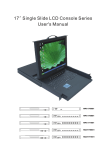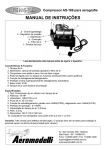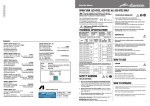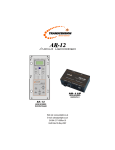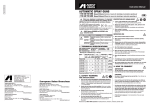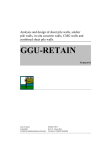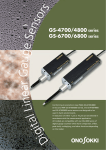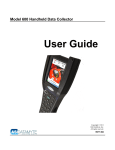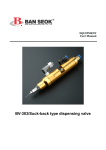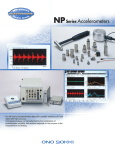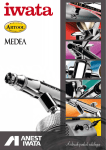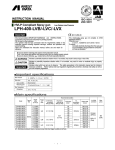Download Instruction Manual
Transcript
INSTRUCTION MANUAL ■PRESSURE TANK PET-10 This manual contains IMPORTANT WARNINGS and INSTRUCTIONS. Equipment in this manual is exclusively for painting purposes. Do not use for other purposes. The operator shall be fully conversant with the requirements stated in this instruction manual including important warnings, cautions and operation and correct handling. Read and understand the instruction manual, before use and retain for reference. This Anest-iwata pressure tank complies to ATEX regulations 94/9/EC, Protection level : Ⅱ2 G T6 X,Suitable for use in Zones 1 and 2. X marking : Any static electricity discharge from the pressure tank is to be diverted to the grounded by connecting stipulated. ■Contents Important information 1. Safety precautions・・・・・・・・・・・・・・・・・・・・・・・・・・・・2 2. Check the products・・・・・・・・・・・・・・・・・・3 3. Specifications・・・・・・・・・・・・・・・・・・・・・・・・・・・・・4 4. Name of each section an d function・・4 5. Installation・・・・・・・・・・・・・・・・・・・・・・・・・・・・・・・・・5 6. Operation・・・・・・・・・・・・・・・・・・・・・・・・・・・・・・・・・・・6 7. Maintenance・・・・・・・・・・・・・・・・・・・・・・・・・・・・・・・7 8. Problems and remedies・・・・・・・・・・・・8 9. Parts list・・・・・・・・・・・・・・・・・・・・・・・・・・・・・・・・・・・・9 -1- ■1.Safety precautions Wear protective gear. During painting, be sure to wear protective gear such as glasses, mask or gloves. Paints or solvents might enter your eyes or you might inhale them. If you feel any abnormality during operation, immediately see a medical doctor. Be careful about ventilation. ・ Use it in a well-ventilated place. Painting or cleaning in a narrow place with insufficient ventilation can cause organic solvent poisoning by sprayed mist of paint or volatile solvent. If you feel any abnormality during operation, immediately see a medical doctor. ・ Sprayed mist of paints or solvents can catch fire, causing fire or explosion, which is very dangerous. Danger caused by wrong operation of equipment ・ Never use in another way than to apply pressure for paint transfer. If done, it can cause insufficient performance or failure. ・ Do not use with corrosive liquids ( halogenated hydrogen carbon, oxygen, alkaline) . If done, corrosion can cause failure. If you consider use of a special cleaning solvent, we are ready to supply you with a material list of our pressure tank on request. ・ Never point paint (gun) toward a person or animal, or put your finger in front of tip of air cap. If done, paint can enter human body directly through eyes, mouth or skin. It is very dangerous. Keep away from origins of explosion or fires. ・ Never use near sparks or open fire. Especially the following will cause fire. It is very dangerous. ・ Open flames such as cigarettes or pipes ・ Electric goods such as stoves, lamps or heaters Contact grounding. ・ Securely ground pump, spray gun, workpieces and containers containing paints or solvent. Be sure to use Anest Iwata’ s designated urethane air hose (EAHU type) with built-in ground wire to have continuous grounding between pump and spray gun or connect grounding separately. Insufficient grounding will cause explosions or fire if exposed to a spark of static electricity. Insufficient grounding will cause explosions or fire if exposed to a spark of static electricity. Be careful about explosion of fluid hose. ・ Never bend hose with a radius of less than 50mm. Never put heavy things on it. If done, hose can explode, causing great danger. ・ Securely connect hose to avoid leak and looseness. If hose is disconnected during operation, hazardous hose movement and paint ejection will cause severe bodily injury. ・ Never use the following hoses. Such a hose can cause great danger during operation. It is very dangerous. ・ cracked ・ damaged ・ bent ・ crushed or distorted -2- Be careful about explosion. ・ Be sure to use it at less than maximum fluid operating pressure. If done, it can cause damage to the pressure tank or emission of paint or flying parts, resulting in serious bodily injury. ・ Never remove safety valve or alter setting figures. If done, it makes it difficult to deal with emergencies, resulting in explosions or accidents. ・ Be sure to release pressure in pressure tank before inspecting or cleaning inside of pressure tank. If not done, it can cause serious bodily injury through eruption of paint or flying parts. Before maintenance or inspection, be sure to release compressed air in pressure tank and make sure by checking pressure gauge that there is no pressure remaining in the pressure tank. If you do Maintenance or inspection while pressure remains in tank, parts being disassembled can fly out and caus injury. ・ Never alter the pressure tank. ・ Be sure to use our genuine parts when you make repairs or replace parts. If not, it can cause insufficient performance or failure. ■2. Check the products ・Check to make sure that the products are as ordered and that the products have not been distorted or damaged. Front Back Check the accessories. Check that accessories have been included. ◎ Pressure regulator ass’ y ◎ Handle ◎ Instruction manual Nut Pressure regulator ass’y -3- Handle Instruction manual How to connect Secure pressure regulator ass’ y and handle with nut on tank. Firmly fix handle or pressure regulator ass’ y to tank. If not, drop of tank can cause bodily injury. ■3. Specifications Model PET-10 Capacity Inner tank capacity (SUS304) Max. working pressure Ambient temperature For tank Pressure regulator ass’ y For spray gun Max. operating air pressure Air inlet/Air outlet Fluid tube (SUS303) Fluid outlet (SUS303) Fluid passage Dimensions, LxWxH mass Mass 10L 8.5L 4.0 bar/ 57psi 5∼40℃ 4.0 bar/ 57psi 7.0bar/100psi G1/4 1/2” G3/8 Stainless Steel 310x310x565 mm 11.6 kg ■4. Name of each section and function Pressure tank feeds paint in pressure tank by pressure which is adjusted by a pressure regulator. Air outlet G1/4 connection to air hose. Air inlet G1/4 connection to air hose. Safety valve Releases air when air pressure inside pressure tank. Max: 4.0bar / 57psi Exhaust valve Exhausts air pressure in pressure tank. Rotate exhaust valve in anticlockwise direction. Pressure regulator (spray gun) Supplies regulated air to spray gun. Max: 7.0bar/100psi Pressure regulator (tank) Supplies regulated air to pressure tank. Max: 4.0bar/57psi -4- Paint outlet G3/8 connection to fluid hose. Fluid tube Feeds paint to outside of paint tank through tube. 1/2” Inner tank 8.5L Thumb nut ■5. Installation ・ It can cause an unpredictable accident if pressure tank suddenly moves or topples. ① Install pressure tank on a horizontal surface so that it does not move. ② Securely connect air hoses to inlet and outlet sides and fluid hose. Spray gun prepare separately Air hose prepare separately Air outlet G1/4 Air inlet G1/4 Air hose prepare separately Fluid hose prepare separately Paint outlet G3/8 -5- ■6. Operation 6−1.Preparation Be sure to release compressed air before you lift lid and inspect the inside. If not done, flying parts can cause serious injury. ① Open exhaust valve and release compressed air. If you loosen thumb nut while compressed air remains in pressure tank, flying parts or paint can cause serious injury or accidents. ② Loosen thumb nut, lift lid and inspect the inside of pressure tank. If the inside has become dirty, clean it and pour paint which is filtered. ③ Close lid and securely tighten thumb nut. Tighten it evenly. ④ Securely connect air hose to air hose connection, and fluid hose to fluid hose connection. ⑤ Close exhaust valve. 6−2.Start-up operation and adjustment ɾNever remove safety valve or alter setting figures. If done, safety valve cannot deal with emergencies, resulting in an explosion or accident. If shaft of safety valve becomes dirty clean it. Dirty shaft can cause failure, explosion or accident. If it is damaged or bent, you must ask a specialist to repair it. Safety valve has been adjusted to operate as follows: 4bar{ 57psi} ɾ ① Supply compressed air. Gradually tighten pressure regulator handle to get necessary pressure. If pressure becomes too high, loosen pressure regulator handle. Air release valve fitted to pressure regulator automatically releases air pressure in accordance with loosened value. Readjust and fix it after pressure becomes stable. ② Test spray During spray test, fully adjust both fluid pressuring air pressure and atomizing air pressure. Relationship between fluid pressurizing pressure and atomizing air pressure ③ After spray test, start normal coating job. -6- 6−3.End of operation ① Stop supply compressed air, open exhaust valve to release compressed air pressure in pressure tank. ② Fully return pressure regulator handle (Air release device fitted to pressure regulator releases air from l ower section of handle but this is not a failure) ③ Remove lid and take out paint in container. ④ Securely tighten lid, feed compressed air into pressure tank and exhaust paint in fluid hose. ⑤ After exhausting paint, stop supply compressed air at air inlet again and turn it to the left till handle movement of pressure regulator becomes light. ⑥ Clean inside of pressure tank which is in contact with paint. 6−4. Precautions during operation ・As safety valve has been adjusted during assembly at plant, do not readjust it. If done, it can cause pressure to become higher than necessary and become dangerous. ・Dirty safety valve fails and can also be dangerous. Pay special attention to this point. Safety valves for have been adjusted to operate at 4bar{ 57psi} . ・Be sure to release air pressure in pressure tank before replenishing paint. If not done, parts can fly and paints scatter, which is very dangerous. ・Be sure to filter air through air filter and supply clean air without moisture and oil to pressure tank. If not done, air including moisture and oil can fail paint finish. ・Do not fill pressure tank to more than 80% of its capacity. If done, paint sticks to lid during transportation, damages rubber valve of pressure regulator or reverses flow of paint. ■7. Mai nt enance ・When disassembling, be sure to turn handle of pressure regulator counterclockwise, and slacken it completely. If not done, pressure can cause parts to fly and paint to scatter, causing serious bodily injury. -7- ・ Refer to the following table and do the inspection and maintenance. No. 1 Period Daily inspection Contents of inspection and maintenance ① Check cleanliness of safety valve. ・ Clean if appearance is dirty. ・ If safety valve fails, ask a specialist to repair it. ② Check motion of pressure gauge pointer and any damage to glass. Replace if necessary. ・ Check if pointer returns to 0 position when pressure is not put. ・ Check if pointer moves up gradually when you put pressure gradually. ・ Check to make sure that glass is not broken. 2 Periodic inspection ① Clean pressure tank fully after use. Clean especially suction tubes and fluid hoses with solvent. ② Visually check inside and outside of the unit. ・ any deformation and crack of tank ・ any deformation of tank lid ・ tightening thumb nut and bolt ・ air leak from tank lid packing ■8.Problems and remedies Ask the distributor or the shop who sold it to you about ☆ marked items. If they are not done properly, it can cause poor performance. Problems Causes Research Remedies ①Pressure does not increase ① Forget supply compres ①Open exhaust valve and ①Supply compressed ( in tank) . sed air. check exhaust of air. air fully. ②Exhaust valve and thumb ②Air exhausting sound is nut are not tightened. heard (not heard whe ②Close fully. n normal) ③Pressure gauge is dama ③Air exhausting sound is ③Replace with new ged. heard one ☆ ②Paint does not ①Compressed air is not ①Open exhaust valve and ① ・Supply compressed air fully. check exhaust of air. supplied. ・ Tighten pressure regulator. come out. ②Forget supply compress ②-dittoed air. ②-ditto- ③Remove lid and inspect ③Replenish paint. inside. ③Paint runs out. -8- ■9. Parts list Pressure tank PET-10 № 1 2 3 4 6 7 10 22 24 25 29 Description Main body Lid assembly Gasket Handle Release valve Adapter (G1/4) Pressure regulator Safety valve Fluid outlet (SUS) Pressure gauge Screw bolt 30 Washer Q’ty 1 1 1 1 1 2 1 1 1 2 4 № 31 32 33 34 39 45 46 47 48 49 50 Description Thumb nut C-snap ring Cotter pin Fluid tube (SUS 1/2”) Air flow guider Adapter Adapter Adapter Pressure regulator Fluid outlet adapter(SUS G3/8) Nut 4 51 Inner tank -9- (SUS) Q’ty 4 8 4 1 1 1 1 1 1 1 1 1 ˙ Important information-Safety precautions ・This product is exclusively used for coating. Do not use for other purposes than coating. ・Be sure to read and understand this instruction manual for correct operation. The operator shall be fully conversant with the requirements stated within this instruction manual including important warnings, cautions and operations. ・Wrong operation (mishandling) can cause serious bodily injury, death, fire or explosions. ˔Safety factor ・ Safety precautions in this instruction manual are minimum requirements. Observe other regulations about electricity, safety and fire fighting designated by your country, local government and company. ・ Pay special attention to items which are shown by the below marks and symbols. ・ Marks and symbols mean as follows: ・ Marks of warnings and cautions Indicates a potentially hazardous situation which, if not avoided, could result in death or serious injury. Indicates a potentially hazardous situation which, if not avoided, may result in minor or moderate injury or property damage. Examples of symbols Indicates [you must be careful]. We will explain briefly in or near the symbol. (The example on the left is [be careful about ventilation].) Indicates [you must not do]. We will explain briefly in or near the symbol. (The example on the left is [Do not touch].) Indicates [you must do]. We will explain briefly in or near the symbol. (The example on the left is [be sure to wear protective mask].) ※We shall not be responsible for any injury or damage caused by disregard of warnings, cautions or instructions. ˔ Supplementary notes Important Indicates notes which we ask you to observe. They are helpful to achieve full performance and function of the equipment. 3176,Shinyoshida-cho, Kohoku-ku, Yokohama 223-8501, Japan Manual No.T410-00 Code No.04016010













